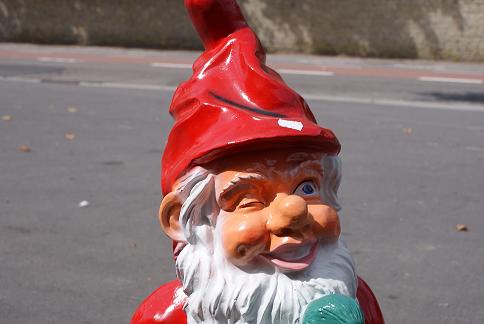
February 2, 2009

Is any of this even true? The following is taken and summarized from Wikipedia.
The Nain Rouge, French for “red dwarf” or “red gnome” is a mythical creature that originated in Normandy, France, as a type of lutin (the French name, male, for a type of hobgoblin (an amusing goblin), in French folklore and fairy tales; females are called lutines).
The hobgoblin of Normandy is similar to house-spirits of England, Germany and Scandinavia. It sometimes takes the form of a horse, and in this shape is called Le Cheval Bayard.
Lutin is generally translated into English as: brownie, elf, fairy, gnome, goblin, hobgoblin, imp, leprechaun, pixie, pixy, puck, or sprite.
In a French fairy tale, “Le Prince Lutin,” written in 1697 has a description of the air, water and terrestrial lutin: “You are invisible when you like it; you cross in one moment the vast space of the universe; you rise without having wings; you go through the ground without dying; you penetrate the abysses of the sea without drowning; you enter everywhere, though the windows and the doors are closed; and, when you decide to, you can let yourself be seen in your natural form.”
In this story a red hat with two feathers makes the Lutin invisible.
Lutins also assist Père Noël in Lapland.
Ah, again, the Wildman, Saint Nicholas, Santa Claus…and the Elves.
In the United States, Nain Rouge haunts Detroit, Michigan, and is feared by its residents as “the harbinger of doom.” (Skinner 1896) Its appearance is said to presage terrible events for the city [like a banshee]. The Nain Rouge appears as a small child-like creature with red or black fur boots. It is also said to have “blazing red eyes and rotten teeth.” (Skinner 1896)
The creature is said to have been attacked in 1701 by the first white settler of Detroit, Antoine de la Mothe Cadillac, who soon after lost his fortune. The creature is also said to have appeared on July 30, 1763 before the Battle of Bloody Run, where 58 British soldiers were killed by Native Americans from Chief Pontiac’s tribe.The small tributary of the Detroit river, which still flows through what is now Elmwood Cemetery, turned red with blood for days after the battle. It is said he was seen dancing on the banks of the Detroit river.
Famous multiple sighting occurred in the days before the 1805 fire which destroyed most of Detroit. General William Hull reported a “dwarf attack” in the fog just before his surrender of Detroit in the War of 1812.
A woman claimed to have been attacked in 1884, and described the creature as resembling, “a baboon with a horned head…brilliant restless eyes and a devilish leer on its face.” Another attack was reported in 1964.
Other sightings include the day before the 12th Street Riot in 1967 and before a huge snow/ice storm of March 1976, when two utility workers are said to have seen what they thought was a child climbing a utility pole which then jumped from the top of the pole and ran away as they approached.
More recently, in the autumn of 1996, according to an article in the Michigan Believer, the Nain Rouge was spotted by two admittedly drunken nightclub patrons, who claimed to both have heard a strange “cawing sound, similar to a crow,” coming from a “small hunched-over man” who was fleeing the scene of a car burglary. The creature was described as wearing “what looked like a really nasty torn fur coat.”
Detroit Beer Co., a brewpub in downtown Detroit, has as its signature brew a “Detroit Dwarf” lager, named in honor of the Nain Rouge.
Various alleged sources: “Le Prince Lutin” by Marie Catherine d’Aulnoy in her Fairy Tales (Les Contes des Fees, 1697); Myths and Legends of our Lands, vol. 6, by Charles M. Skinner, 1896; Legends of Le Détroit by M.C.W. Hamlin, 1884.

Have you heard any of these stories of the “Nain Rouge”? The crimson threads between the Nain Rouge and the imagery in the film Don’t Look Now (1973) and the allied cinema reflective references are certainly there. But the hairs on the back of my neck stand up. Are such stories merely gamer fantasies or created fictions based on a few threads of folklore?
Well, at least the brewery is real and so is the brew, allegedly based on the tale of the Nain Rouge:
The Detroit Dwarf
Copper/amber in color, cloudy, strong in alcohol (6.8% ABV). Clean lager character with some fruity ale notes. Earthy with flavors of tea and forest nuts. Distinct balance between malt and hops allows the creamy texture to really come through. We earned a medal at the Great American Beer festival in our first year of business with this one and it remains our house specialty to this day.
Red’s Rye (bottle pictured below) appears to be Michigan ale that also is related to the Nain Rouge folklore tied to Detroit.
If you are from Michigan, have you ever heard of any of these stories, in addition to the beer and ale?
Thanks to Dr. Benway for mentioning the name. Thanks to Ben Fairhall for the scarlet imagery metaphor.
About Loren Coleman
Loren Coleman is one of the world’s leading cryptozoologists, some say “the” leading living cryptozoologist. Certainly, he is acknowledged as the current living American researcher and writer who has most popularized cryptozoology in the late 20th and early 21st centuries.
Starting his fieldwork and investigations in 1960, after traveling and trekking extensively in pursuit of cryptozoological mysteries, Coleman began writing to share his experiences in 1969. An honorary member of Ivan T. Sanderson’s Society for the Investigation of the Unexplained in the 1970s, Coleman has been bestowed with similar honorary memberships of the North Idaho College Cryptozoology Club in 1983, and in subsequent years, that of the British Columbia Scientific Cryptozoology Club, CryptoSafari International, and other international organizations. He was also a Life Member and Benefactor of the International Society of Cryptozoology (now-defunct).
Loren Coleman’s daily blog, as a member of the Cryptomundo Team, served as an ongoing avenue of communication for the ever-growing body of cryptozoo news from 2005 through 2013. He returned as an infrequent contributor beginning Halloween week of 2015.
Coleman is the founder in 2003, and current director of the International Cryptozoology Museum in Portland, Maine.
Filed under Cryptomundo Exclusive, Cryptotourism, CryptoZoo News, Folklore, Pop Culture, Proto-Pygmies, Public Forum, Twilight Language